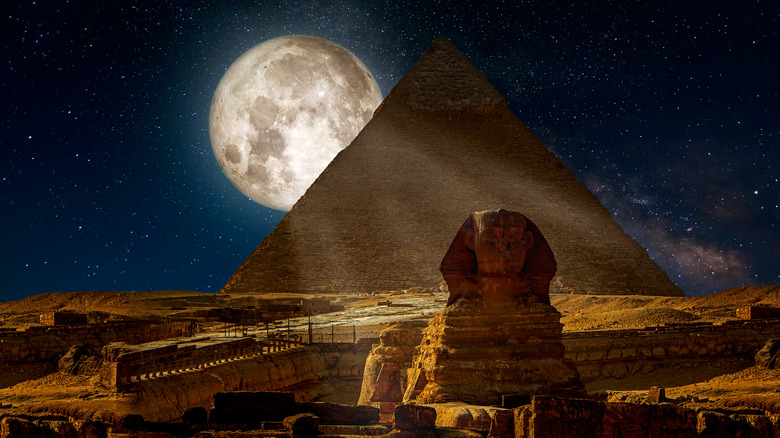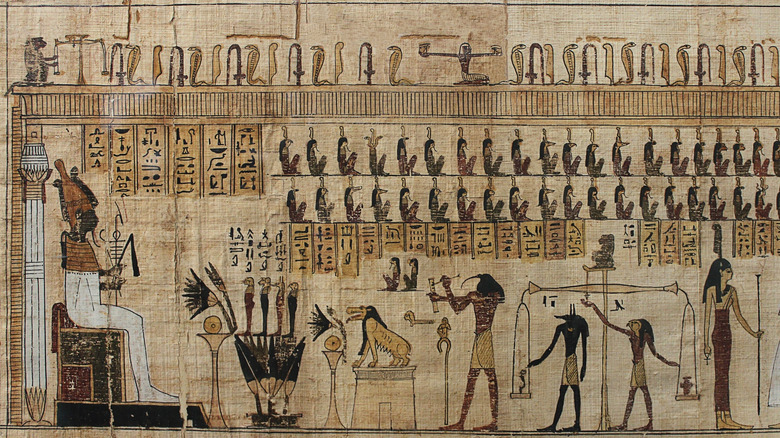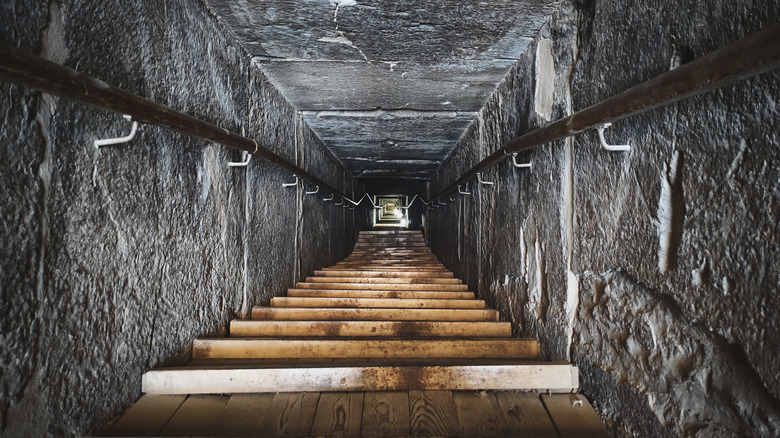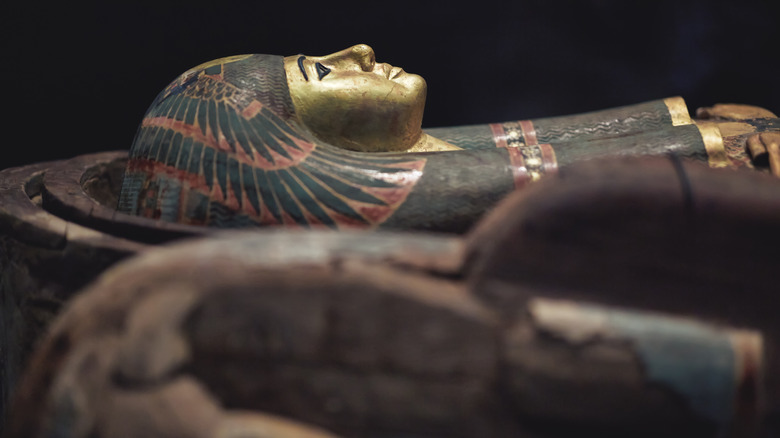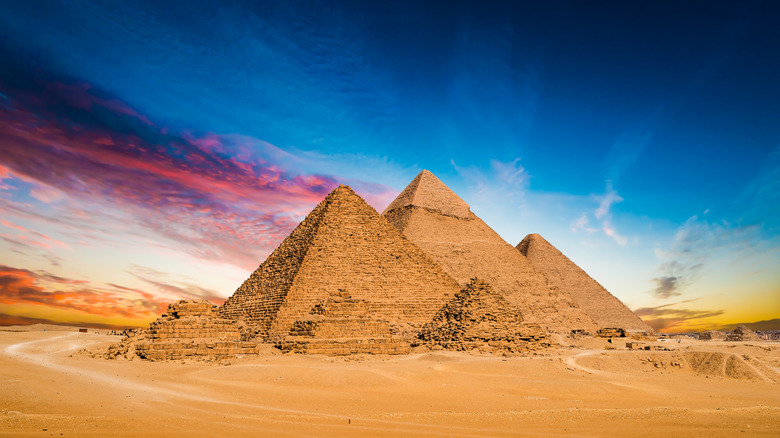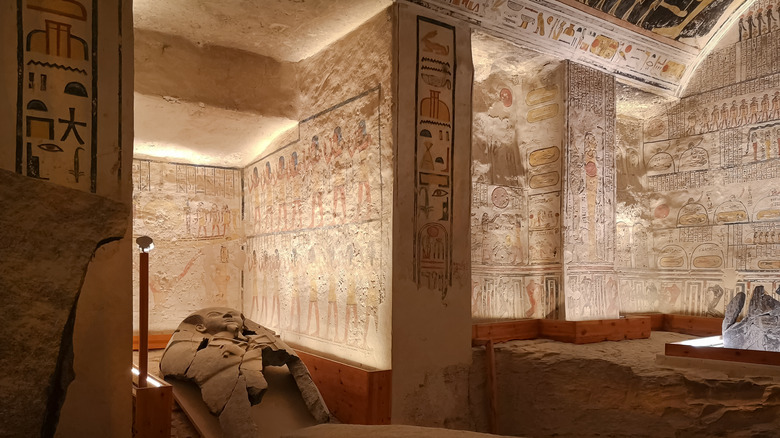The Mystery Behind Where King Khufu's Body Is Buried
Few mysteries have captivated hearts and minds like those of ancient Egypt – and looming larger than life in the background of such stories there often lies a king, a pyramid, or an ancient burial. The case of King Khufu involves all three. The Egyptian pharaoh known as Khufu (or alternatively the Greek form of the name, Cheops) had a serious claim to fame. His reign over the Fourth Dynasty during the period of Egyptian history known as the "Old Kingdom" is shrouded in uncertainty, but one thing is clear: He is the leader responsible for the Great Pyramid at Giza (via BBC).
According to PBS, the Great Pyramid, which towers over Giza at a height of 481 feet, was the tallest building on Earth for thousands of years. Of all the 100 known pyramids built in Egypt at the time, the Great Pyramid stood out as one of the Seven Wonders of the World, per History. Crafted out of approximately 2.3 million blocks, historians have marveled at its enduring limestone exterior, pondering how it was constructed with such precision.
Perhaps even more fascinating than that is the mystery of what treasures were once inside. Could this pyramid have once contained the remains of Khufu, one of Egypt's most famous Pharaohs? If so, which room served as his burial chamber? More importantly, are the lost remains still hiding inside, in a secret room that's yet to be discovered?
Khufu's life is highly debated among scholars
According to the BBC, there are several conflicting stories regarding the life and leadership style of the second ruling Pharoah of Egypt's Fourth Dynasty. The Greek historian Herodotus described Khufu as a wicked slave driver who built the Great Pyramid on the backs of hard-working civilians. Per Herodotus, Khufu was so heartless that he once sexually exploited his daughter for monetary gain to maintain his affluence. But while Herodotus' narrative is one of the more widespread stories out there about Khufu, it's not the only theory in the think tank.
The Westcar Papyrus, an ancient Egyptian scroll dating back to Egypt's Second Intermediate Period, described Khufu as a much more likable individual. Kind to his people and agreeable, per the account, Khufu made use of "conscripted labor." Though it's important to note that while this kind of labor wasn't (and, per historians, isn't) technically defined as slavery, it is still forced labor made compulsory by government demands. The difference, however, is that conscripted labor is a short-term imposition that some viewed (and view) as a tax paid by the working class to the elites, whereas chattel slavery denoted a lifetime of laboring and "the legal ownership of a human being," per the New World Encyclopedia.
Knowing what kind of king Khufu was could clue historians in on the whereabouts of his remains. Alas, little is left aside from his legend — and of course, the pyramid believed to hold his mummified corpse.
The Great Pyramid's interior seemingly consists of three rooms
According to Britannica, the elaborate design of the Great Pyramid's exterior is a stark contrast to its relatively simple interior. Between the ornate limestone walls, there seem to exist just three chambers: the Queen's Chamber, the King's Chamber, and the Grand Gallery. Per PBS, there is also a subterranean chamber plummeting 90 feet beneath the surface of the Great Pyramid, under the weight of millions of massive limestone rocks. Interestingly enough, Pharoah Djoser (whose Egyptian name was Netjerykhet) was buried in a subterranean chamber — one also situated 90 feet beneath the oldest known pyramid in the world, according to Live Science.
However, historians largely agree that the chamber beneath the Great Pyramid did not contain the remains of King Khufu, as it was unfinished at the time of his death. While the names of some of these chambers are a bit misleading (the Queen's Chamber, for instance, was likely a vault for the kings' riches and gifts, per The Sydney Morning Herald), the original location of King Khufu's remains was, until a certain point, never called into question. But in the early 2000s, a pair of amateur Egyptologists first presented their interesting proclamation of a possible secret fourth room. Though the theory is somewhat obscure outside of Egyptology, it has yet to be debunked or confirmed.
Khufu's mummy was long believed to have been stolen
According to a 2004 piece published by The Sydney Morning Herald, the empty granite sarcophagus abandoned in the King's Chamber section of the Great Pyramid was always believed to have been the original location of Khufu's mummified remains. If Khufu's body had indeed been stolen, it made sense that tomb robbers had left the heavy stone coffin behind. But it seems another scenario entirely is also possible.
But as The Guardian reported in 2004, French Egyptologists Gilles Dormion and Jean-Yves Verd'hurt, who conducted radar analysis on the Great Pyramid, spun another theory about the Great Pyramid's empty sarcophagus. According to them, it was possible that the Great Pyramid wasn't conceptualized in the beginning as a resting place for kings. Rather, the interior was rearranged multiple times to make room for Khufu's future burial site, evolving as each passing room was deemed insufficient for this purpose.
To put it simply, their theory can be summarized via the following quote from Dormion (via The Guardian): "Khufu had three funeral chambers built for himself. The first remained unfinished, the second was available and the third cracked. Khufu was therefore interred in the second." If true, this would mean that King Khufu's remains were never stolen from the King's Chamber — and that they are still inside the pyramid in a room nobody has seen for millennia.
There could be a hidden room in the Great Pyramid
To further expound upon their theory, Gilles Dormion and Jean-Yves Verd'hurt pointed to cracks in the structure's plaster that date back 4,500 years. In a 2004 interview with The Guardian, the French Egyptologists pointed to the cracked third room within the Great Pyramid as possible evidence of another. They suspected that the hidden room, where the body might still be found, was then interned in this hypothetical room after the previous sustained unexpected damage.
As The Sydney Morning Herald also noted in 2004, scholar Jean-Pierre Corteggiani of the French Institute of Oriental Archaeology in Cairo theorized that Dormion and Verd'hurt are correct and that the place where they believe the second room is situated is actually right in the heart of the Great Pyramid of Giza. This would make sense, given the fallen Pharoah's love of symbolism.
Adding to the ancient mystery, further investigation into whether or not a hidden room exists has been halted by the Egyptian Supreme Council of Antiquities. This organization has, as of this report, refused to allow these two historical sleuths to proceed with their screenings. For now, the truth is buried behind limestone and legislative red tape.
Egyptologists have used radar to look for hidden rooms in pyramids
Some of the world's greatest mysteries are buried in plain sight. Could this be the case for the remains of King Khufu? While the story has a distinct air of urban legend, stranger things have certainly been unearthed by Jean-Yves Verd and Gilles Dormion — with a little help from their sophisticated ground-penetrating radar.
In 1998, Dormion and Verd'hurt discovered not one but two hidden rooms in the Meidum Pyramid situated in what Egyptologists refer to as Lower Egypt (via Fox News). Since then, they have conducted thorough analyses of other sites across Egypt; however, both men are regarded by some as amateurs in the field, per The Guardian. After positing their theory in 2004, they queried again for permission to scan the Great Pyramid of Giza in 2015 but were ultimately denied the opportunity. Since then, their research has sparked other archeological projects, like the 2020 survey of the Snefru Pyramids at Dahshur (via Research Gate). Still, the Great Pyramids remain untouched, a mystery to be unraveled.
